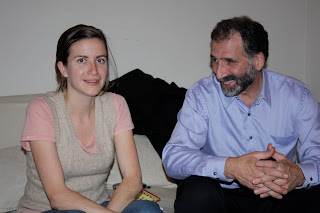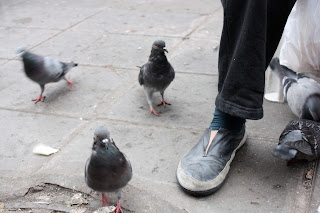According to the proprietors of
Graffiti Mundo Tour in Buenos Aires, most street artists in the capital paint "porque es lindo pintar." It sure
is nice to paint, isn't it?
Latin America has a long and fascinating history of muralism. However, in contrast to many of its regional neighbors, Argentina's public paintings are a more recent phenomenon--less historical and less politically revolutionary. Graffiti arrived in 1990s, created by mostly middle class artists emulating "cool" U.S. work born out of the hip-hop movement. The severe economic crisis of 2001 inspired a great deal of different work in Buenos Aires - mostly new political commentary and expression of rage. Quickly, artist collectives also formed to combat the malaise and frustration. One of the first street art groups intentionally aimed to animate the public mood and make poeple smile by painting enormous, silly cartoons on the walls in primary colors.
Since then, the work is often created by established artists who also show in galleries or are professional graphic designers. There is way less taboo in Argentina than in U.S. for commercials artists to engage in graffiti. (However, not unlike graffiti in the U.S., it's a bit of a boys' club in B.A. While there are few women on the scene at the moment, there is one who is highly respected and goes by the moniker Pum Pum.)
All wall-painting is illegal except for private property, and of all the problems in this city, graffiti is not considered the highest priority for law enforcement. Police are only allowed to respond to complaints, which means they don't chase artists randomly. So, it is essentially legal making it not exactly graffiti afterall.... When artists do not have run from the law, the art changes. It allows them to take more time and paint during the daytime with exterior latex paint (way less aerosol and wheat pasting, way less nighttime work). The general
porteño attitude towards street art is far more tolerant. There are no planning committee regs to wrestle, few permits to secure, if any. Some private property owners even ask painters to cover the walls of their homes. A tagger is less likely to spoil a completed mural, whereas a clean empty wall is fair game.
In 2000 I attempted to complete a public mural project with a group of teenagers in Cambridge, MA. The red tape we encountered became as much a lesson to us as the process of collectively designing the image who had hoped to share with the community. Now, had we been in Buenos Aires...hmm....
Overall, one of my favorite aspects of work on the walls is the dialectical nature of it: painters interact with each other's work in "collaboration"- sometimes knowingly, sometimes unsolicited. Many images are ever-changing. And, the higher up you can paint, the better. Low-quality taggers and political propagandists don't usually have ladders to mess with your work!
I learned much more and took detailed notes, so if you are interested in the stories of specific pieces or artists you see in the slideshow, let me know. Most of my information comes from the Graffiti Mundo guides. If you ever find yourself in Buenos Aires, I highly recommend this tour company with tours in English and Spanish. No flight reserved? There is a good deal of info on the website as well.
















